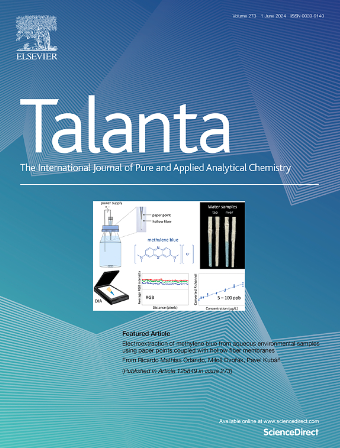Novel fluorescent ficin-templated Ni nanoclusters for nucleus imaging: a green and biocompatible alternative to traditional DNA stain
IF 5.6
1区 化学
Q1 CHEMISTRY, ANALYTICAL
引用次数: 0
Abstract
Fluorescence imaging of subcellular structures is crucial for understanding cellular functions and disease mechanisms. However, existing fluorescent dyes are plagued by inadequate biocompatibility and insufficient stability, which impede the advancement of high-resolution, long-term, and live-cell imaging. In this work, we innovatively synthesized a novel nickel nanocluster encapsulated with ficin (Ficin-Ni NCs) through a straightforward biomineralization approach as a fluorescent probe for imaging the nucleus. The Ficin-Ni NCs with intense green fluorescence exhibited a particle size of approximately 1.56 nm, significant Stokes shift (110 nm), and remarkable stability (98 % fluorescence intensity after 14 days). Meanwhile, the Ni NCs demonstrated excellent biocompatibility, maintaining cell viability above 90 % for both Raw264.7 and HEK-293T cells at a concentration of 60 μg/mL. Significantly, DNA gel electrophoresis experiments, using ethidium bromide (EB) as a reference, confirmed the ability of the NCs to bind DNA. Furthermore, the as-prepared Ficin-Ni NCs could achieve precise imaging of cell nuclei consistent with 4’,6-diamidino-2-phenylindole (DAPI) within 15 min in a variety of animal cells, including HEK-293T cells, Raw264.7, bullfrog erythrocytes, and human oral epithelial cells. Simultaneously, Ni NCs also demonstrated remarkable potential for visualizing the nuclear structures in plant cells, such as onion and cinnamon epidermal cells. Therefore, this innovative fluorescent probe, initially prepared via biomineralization, emerges as a promising alternative to traditional EB or DAPI dyes, paving the way for rapid response, effectiveness, and reusability in cellular imaging.

用于核成像的新型荧光纤维模板镍纳米簇:传统DNA染色的绿色和生物相容性替代品
亚细胞结构的荧光成像对于理解细胞功能和疾病机制至关重要。然而,现有的荧光染料受到生物相容性不足和稳定性不足的困扰,这阻碍了高分辨率,长期和活细胞成像的发展。在这项工作中,我们通过直接的生物矿化方法,创新地合成了一种新型的用ficin包裹的镍纳米簇(ficin - ni NCs)作为荧光探针,用于核成像。具有强烈绿色荧光的Ficin-Ni NCs具有约1.56 nm的粒径,显著的Stokes位移(110 nm)和显著的稳定性(14天后荧光强度达到98%)。同时,Ni NCs对Raw264.7和HEK-293T细胞均表现出良好的生物相容性,在浓度为60 μg/mL时,细胞存活率均维持在90%以上。值得注意的是,以溴化乙锭(EB)为对照的DNA凝胶电泳实验证实了NCs结合DNA的能力。此外,制备的Ficin-Ni NCs在HEK-293T细胞、Raw264.7、牛蛙红细胞和人口腔上皮细胞等多种动物细胞中,可在15分钟内实现与4′,6-二氨基-2-苯基吲哚(DAPI)一致的细胞核精确成像。同时,Ni NCs在植物细胞(如洋葱和肉桂表皮细胞)的细胞核结构可视化方面也表现出了显著的潜力。因此,这种创新的荧光探针,最初通过生物矿化制备,成为传统EB或DAPI染料的有希望的替代品,为细胞成像的快速反应,有效性和可重用性铺平了道路。
本文章由计算机程序翻译,如有差异,请以英文原文为准。
求助全文
约1分钟内获得全文
求助全文
来源期刊

Talanta
化学-分析化学
CiteScore
12.30
自引率
4.90%
发文量
861
审稿时长
29 days
期刊介绍:
Talanta provides a forum for the publication of original research papers, short communications, and critical reviews in all branches of pure and applied analytical chemistry. Papers are evaluated based on established guidelines, including the fundamental nature of the study, scientific novelty, substantial improvement or advantage over existing technology or methods, and demonstrated analytical applicability. Original research papers on fundamental studies, and on novel sensor and instrumentation developments, are encouraged. Novel or improved applications in areas such as clinical and biological chemistry, environmental analysis, geochemistry, materials science and engineering, and analytical platforms for omics development are welcome.
Analytical performance of methods should be determined, including interference and matrix effects, and methods should be validated by comparison with a standard method, or analysis of a certified reference material. Simple spiking recoveries may not be sufficient. The developed method should especially comprise information on selectivity, sensitivity, detection limits, accuracy, and reliability. However, applying official validation or robustness studies to a routine method or technique does not necessarily constitute novelty. Proper statistical treatment of the data should be provided. Relevant literature should be cited, including related publications by the authors, and authors should discuss how their proposed methodology compares with previously reported methods.
 求助内容:
求助内容: 应助结果提醒方式:
应助结果提醒方式:


